Click on images to enlarge

infestation in a creekbed (Photo: Sheldon Navie)
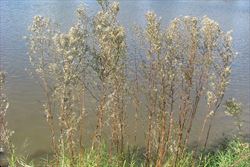
habit of flowering plants (Photo: Sheldon Navie)
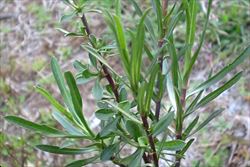
stems and upper leaves (Photo: Sheldon Navie)
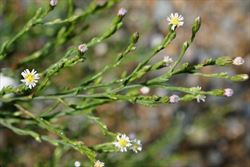
flower-heads (Photo: Trevor James)
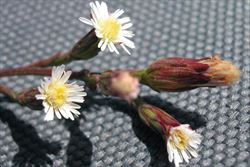
close-up of flower-heads (Photo: Greg Jordan)
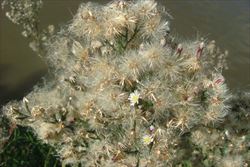
old flower-heads with seeds (Photo: Sheldon Navie)

close-up of seeds (Photo: Sheldon Navie)

young plant with lower leaves (Photo: Sheldon Navie)

habit (Photo: Sheldon Navie)

lower leaves (Photo: Sheldon Navie)
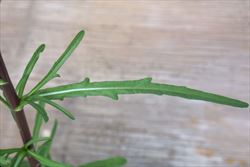
close-up of upper leaves with slightly toothed margins (Photo: Trevor James)

close-up of purplish stem and leaf undersides (Photo: Trevor James)
Scientific Name
Aster subulatus Michx.
Synonyms
Aster squamatus (Spreng.) Hieron. ex Sodiro (misapplied)Symphyotrichum subulatum (Michx.) Nesom
Family
Asteraceae (Queensland, New South Wales, the ACT, Victoria, Tasmania, Western Australia and the Northern Territory)Compositae (South Australia)
Common Names
annual saltmarsh aster, aster, aster weed, aster-weed, bushy starwort, eastern annual saltmarsh aster, saltmarsh aster, sea aster, slender aster, slim aster, small saltmarsh aster, wild aster
Origin
Native to large parts of North America (i.e. eastern Canada, USA and Mexico), Central America (i.e. Costa Rica, Guatemala, Honduras and Nicaragua), the Caribbean (i.e. Cuba and Puerto Rico) and South America (i.e. Venezuela, Brazil, Bolivia, Argentina, Chile, Paraguay and Uruguay).
Naturalised Distribution
This species is very widely naturalised in Australia. It is particularly common in eastern Australia (i.e. throughout Queensland, New South Wales, the ACT and Victoria) and relatively common in southern Australia (i.e. in Tasmania, in many parts of South Australia and in south-western Western Australia. Also naturalised in the southern parts of the Northern Territory and on offshore islands (i.e. Lord Howe Island, Norfolk Island and Christmas Island).
Notes
Wild aster (Aster subulatus) is regarded as an environmental weed in Victoria, South Australia, Western Australia, New South Wales and Queensland. It is a common and widespread weed of gardens, pastures, crops, roadsides, disturbed sites and waste areas. It is also invasive along waterways, in seasonally wet or poorly drained areas, and in permanently damp sites such as wetlands, swamp margins and drainage channels.
In the southern parts of Western Australia it is prominent in saline wetland areas. For example, it is one of a handful of exotic weeds that have replaced native samphire and rush communities along the Swan/Canning and Leschenault estuaries. It is also one of several weeds that are competing with the main surviving population of the endangered Spalding blown grass (Lachnagrostis limitanea) in the Northern Lofty Mountains region in South Australia. Wild aster (Aster subulatus) is also a common weed along the foreshore of Wallaga Lake, a saltwater lake in south-eastern New South Wales that is largely contained within conservation areas. Numerous other conservation areas and wetlands in southern Australia have been invaded by this species (e.g. Phillip Island Nature Park in Victoria, Brownhill Creek Recreation Park and Mount Magnificent Conservation Park in South Australia, and the Mambo Wetlands in New South Wales). It has also been recorded as a weed of arid wetlands in the southern parts of the Northern Territory and as a weed of coastal habitats in Victoria (e.g. on the Mornington Peninsula and in the Point Henry Foreshore Reserve).

